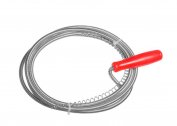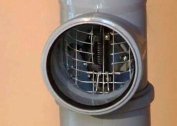Sewerage is a sanitary installation and a network of pipelines collecting human waste products, domestic and rainwater waste water. It is part of the water supply and sanitation system of a modern city and village.
For any type of sewage, sewer pipes are needed. A variety in color and texture suggests the presence of various characteristics for their application. It is not a simple process of arranging a sewer system in a house or apartment. In order not to make mistakes, and then correct them, we must approach this process with full responsibility. After all, the whole sewer system of the room, its effective performance, will envy of the right choice of pipes.
Why pipes of different colors
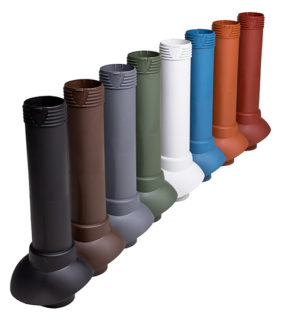 The choice of sewer pipes is an important step in wiring an internal sewage system. For high-quality operation of the entire pipe system, attention is paid to the following elements: fittings, connection methods, manufacturing material. It is also important to choose the diameter and length of the pipes, and here the colors of the pipes will help. The manufacturer has specially created various colors so that the buyer can choose the right pipe according to the destination. So, the color of the pipes denotes its classification. More recently, sewer pipes were of two colors: gray and black. Now there is such a variety of colors: gray, red, black, green, blue, white. To some extent, this complicates the choice, but you just need to know the purpose of the pipes of a certain color.
The choice of sewer pipes is an important step in wiring an internal sewage system. For high-quality operation of the entire pipe system, attention is paid to the following elements: fittings, connection methods, manufacturing material. It is also important to choose the diameter and length of the pipes, and here the colors of the pipes will help. The manufacturer has specially created various colors so that the buyer can choose the right pipe according to the destination. So, the color of the pipes denotes its classification. More recently, sewer pipes were of two colors: gray and black. Now there is such a variety of colors: gray, red, black, green, blue, white. To some extent, this complicates the choice, but you just need to know the purpose of the pipes of a certain color.
Manufacturers can not paint pipes at their discretion, for this there are standards by which production is going on and these rules are mandatory for all companies involved in the production of these products.
If sewer pipes do not fit into the interior of the room by color, then choosing the right color gamut, you need to thoroughly study the product parameters, maybe they will not fit other indicators. Only then make purchasing decisions. A great variety introduces the buyer into a stupor, since he does not know the elementary purpose of a pipe.
Scope of application
 The sewage system is divided into three large sections:
The sewage system is divided into three large sections:
- Sewerage internal wiring network.
- External sewer wiring network.
- Sewage treatment.
The internal wiring network is used inside buildings, as a rule, it is led to water intake devices: bathtubs, sinks, toilet bowls, urinals, bidets, showers - this is a system for collecting wastewater inside the building and delivering them to the external sewer.
External sewage wiring network - the collection of effluents from a building and their discharge to treatment facilities or discharge into a water intake. External sewage can be central, from which the effluents go to special treatment facilities or household, where a water treatment collector can stand. There may also be a household pit into which dirty water is discharged, and then, as it is full, it is pumped out by a sewer machine.
Wastewater - used to collect storm water and quickly remove precipitation, as well as melt water or discharge water from technological enterprises. Water flows into special ditches (arych system) of open type and enters underground pipelines, and from there it can either go to treatment facilities or directly to water bodies. Sometimes such water is diverted directly to sparsely populated places, to forests, to plantings.
Pipe colors and scope
Due to the aggressiveness of the environment that carry drains through sewer pipes, they have serious requirements: the material of manufacture is cast iron, PE (polyethylene), PP (polypropylene), PVC (polyvinyl chloride), ceramic, asbestos-cement. All of them must be strong and durable, and each type of pipe has its own purpose. For, to facilitate the choice of manufacturers, designated sewer pipes in different colors.
Gray
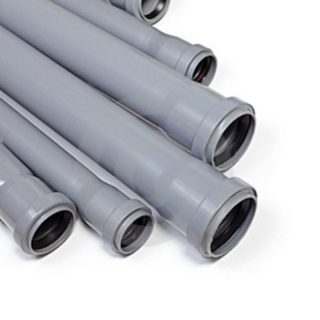 A gray pipe, like a white pipe, is suitable only for internal wiring, it is absolutely not suitable for external sewage, as it is afraid of low temperatures and if an ice plug forms, this can lead to unpredictable consequences.
A gray pipe, like a white pipe, is suitable only for internal wiring, it is absolutely not suitable for external sewage, as it is afraid of low temperatures and if an ice plug forms, this can lead to unpredictable consequences.
The gray pipe is made of polyvinyl chloride, it is not afraid of corrosion, it is not heavy in weight, it is easy to install, in terms of aesthetics it has a neutral color. Pipes vary in size, but they have limitations in diameter.
Redheads
This type of pipe is designed for external sewage, it is made of PVC (polyvinyl chloride), in diameter it is 110, 125, 150 mm - the standard for such pipes. They can be 500, 1000, 2000, 6000 mm in length. Large sizes of pipes are designed to create sewage systems with a large bore, storm sewers and culverts. The thickness of such a pipe is 3.2 mm. Such a pipe can be laid to a depth of 4 m. The temperature regime is from -10 to + 60. A smooth pipe with a bell, according to the stiffness class SN 4, consists of several layers. It is ideal for outdoor sewers.
The material from which the pipe is made is strong, durable, resistant to corrosion and is not afraid of exposure to harmful microorganisms. Such a pipe inside has a smooth structure, which helps to pass various drains without delay. Despite the stiffness and strength, it is not laid under the lines, since it cannot withstand pressure, bends and causes blockage and subsequent damage. Although the ribbed surface and many layers give an additional chance to withstand a large amount of soil.
This pipe is of higher cost, but its service life is high - about 50 years.
Black
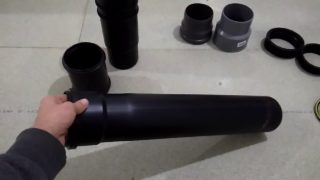 Black pipes made of high pressure polyethylene can be used both indoors and in outdoor wiring. More often they find applications as pipes in which communication cables are laid to protect against moisture. Black pipes are not suitable for piping, as they can not withstand high pressure. If water is conducted without pressure, then it can be used. It is mainly used for sewage from internal sewers. It happens in bays of 40 -50 m and a diameter of 110, 160 and 200 mm. There are also special black pipes with perforation designed for underground drainage.
Black pipes made of high pressure polyethylene can be used both indoors and in outdoor wiring. More often they find applications as pipes in which communication cables are laid to protect against moisture. Black pipes are not suitable for piping, as they can not withstand high pressure. If water is conducted without pressure, then it can be used. It is mainly used for sewage from internal sewers. It happens in bays of 40 -50 m and a diameter of 110, 160 and 200 mm. There are also special black pipes with perforation designed for underground drainage.
Green
Such pipes are often made of cast iron, since this material is distinguished by high strength and durability. There are pipes and plastic. The walls of such pipes are durable, designed to withstand a large layer of soil, have perforation (drainage holes). Use such products for underground drainage - they collect groundwater, withstand temperature extremes.
Blue
Blue pipes are often used for laying the drainage system of rain and melt water inside heated residential as well as industrial buildings. Such pipes are incredibly durable, because risers and drain pipes need to withstand the pressure of the water flow in the event of blockages and overflows in the system.
Whites
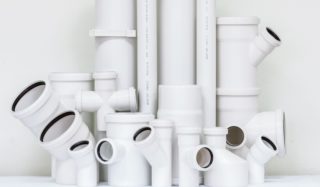 White products for sewage are not so often used, less often than black. If it is not possible to hide the internal pipeline, then white pipes are taken, since gray pipes are difficult to fit into the interior of a bathroom or kitchen. You don’t have to worry about the quality of these pipes, they also meet the parameters of the indoor installation, as well as gray.
White products for sewage are not so often used, less often than black. If it is not possible to hide the internal pipeline, then white pipes are taken, since gray pipes are difficult to fit into the interior of a bathroom or kitchen. You don’t have to worry about the quality of these pipes, they also meet the parameters of the indoor installation, as well as gray.
They can withstand temperature heating up to 950; when choosing such a pipe, you should not worry about its safety. Sound insulation at a height, the diameter of the pipe is diverse in assortment: from 32 mm to 150 mm. In length from 150 to 5000 mm. The layer thickness is about 2.7 mm and of course the pipe has a bell with a rubber ring, which makes the docking installation airtight. Various fittings and connections are easily matched to such pipes.
When it is known for what purpose a sewer pipe is needed, whether it be internal or external wiring, and the required diameter and size are known, it will not be difficult to assemble and bring the pipes, all the more so, no special tools and devices are required.
